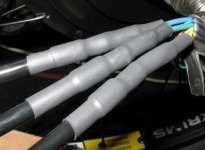oatnet
1 MW
AAARrrrgghh.
I put a connector on the shunt, but it was ugly. The hall and throttle connectors I did earlier today went smooth as silk, but this one, everything that could go wrong on this simple little task, did. I had to do it twice, and the second time was ugly too. Maybe I am just tired and getting sloppy.
Anyhow, so I hooked the shunt up to the BMC bike, and it workedno problem. Then I went to set the shunt value. Turns out this is one of the Beta-version CycleAnalyst's Justin sent me for evaluation back when he was still fishing for a name for it... and it doesn't have an option to set the Rshunt value, so for all practical purposes it is USELESS. I added a speedo cable to it just for this build, I have it all zip-tied and routed through the channel in the frame, and I hacked up a StandAlone cycleanalyst so I wouldn't have to uninstall this one.
I have few new direct-connect Cycleanalysts lying around, so I grabbed one of them and plugged it in loose. A standalone Cycleanalyst I have on one of my TidalForce bikes shows an Rshunt value of 1.399, so I set this new one from the factory default of 1.000 to 1.399. No load it peaks at 105w. Stalled when hold the front brake and crank the throttle, it goes up to 450w. Riding 10' across my ManPit it runs about 250w, and that is at about the max speed it was running before.
AAAArrrrggghh.

I put a connector on the shunt, but it was ugly. The hall and throttle connectors I did earlier today went smooth as silk, but this one, everything that could go wrong on this simple little task, did. I had to do it twice, and the second time was ugly too. Maybe I am just tired and getting sloppy.
Anyhow, so I hooked the shunt up to the BMC bike, and it workedno problem. Then I went to set the shunt value. Turns out this is one of the Beta-version CycleAnalyst's Justin sent me for evaluation back when he was still fishing for a name for it... and it doesn't have an option to set the Rshunt value, so for all practical purposes it is USELESS. I added a speedo cable to it just for this build, I have it all zip-tied and routed through the channel in the frame, and I hacked up a StandAlone cycleanalyst so I wouldn't have to uninstall this one.
I have few new direct-connect Cycleanalysts lying around, so I grabbed one of them and plugged it in loose. A standalone Cycleanalyst I have on one of my TidalForce bikes shows an Rshunt value of 1.399, so I set this new one from the factory default of 1.000 to 1.399. No load it peaks at 105w. Stalled when hold the front brake and crank the throttle, it goes up to 450w. Riding 10' across my ManPit it runs about 250w, and that is at about the max speed it was running before.
AAAArrrrggghh.







